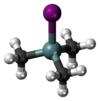Trimethylsilyl iodide
Trimethylsilyl iodide (iodotrimethylsilane or TMSI) is an organosilicon compound with the chemical formula (CH3)3SiI. It is a colorless, volatile liquid at room temperature.
| |||
| Names | |||
|---|---|---|---|
| IUPAC name
Iodo(trimethyl)silane | |||
| Other names
Iodotrimethylsilane; TMSI; TMS-I; Jung reagent | |||
| Identifiers | |||
3D model (JSmol) |
|||
| ChemSpider | |||
| ECHA InfoCard | 100.036.503 | ||
PubChem CID |
|||
CompTox Dashboard (EPA) |
|||
| |||
| |||
| Properties | |||
| C3H9ISi | |||
| Molar mass | 200.094 g·mol−1 | ||
| Appearance | Clear colorless liquid[1] | ||
| Density | 1.406 g/mL[1] | ||
| Boiling point | 106–109 °C (223–228 °F; 379–382 K)[1] | ||
| Hazards | |||
| Flash point | −31 °C (−24 °F; 242 K)[1] | ||
Except where otherwise noted, data are given for materials in their standard state (at 25 °C [77 °F], 100 kPa). | |||
| Infobox references | |||
Preparation
Trimethylsilyl iodide may be prepared by the oxidative cleavage of hexamethyldisilane by iodine[2] or by the cleavage of hexamethyldisiloxane with aluminium triiodide.[2][3]
- TMS-TMS + I2 → 2 TMSI (TMS = (CH3)3Si)
- 3 TMS-O-TMS + 2 AlI3 → 6 TMSI + Al2O3
Applications
Trimethylsilyl iodide is used to introduce the trimethylsilyl group onto alcohols (ROH):
- R-OH + TMSI → R-OTMS + HI
This type of reaction may be useful for gas chromatography analysis; the resultant silyl ether is more volatile than the underivatized original materials.[4] However, for the preparation of bulk trimethylsilylated material, trimethylsilyl chloride may be preferred due to its lower cost.
TMSI reacts with alkyl ethers (ROR′), forming silyl ethers (ROSiMe3) and iodoalkanes (RI) that can be hydrolyzed to alcohols (ROH).[5]
Trimethylsilyl iodide is also used for the removing of the Boc protecting group,[2][6][7] especially where other deprotection methods are too harsh for the substrate.[8]
References
- Michael E. Jung, Michael J. Martinelli, George A. Olah, G. K. Surya Prakash, Jinbo Hu (October 15, 2005). Iodotrimethylsilane. E-EROS Encyclopedia of Reagents for Organic Synthesis. doi:10.1002/047084289X.ri043.pub2. ISBN 978-0471936237.CS1 maint: multiple names: authors list (link)
- Olah, G; Narang, S. C. (1982). "Iodotrimethylsilane—a versatile synthetic reagent". Tetrahedron. 38 (15): 2225. doi:10.1016/0040-4020(82)87002-6.
- Michael E. Jung; Mark A. Lyster (1988). "Cleavage of Methyl Ethers with Iodotrimethylsilane: Cyclohexanol from Cyclohexyl Methyl Ether". Organic Syntheses.; Collective Volume, 6, p. 353
- "GC/MS Analysis for Morphine and Other Opiates in Urine" (PDF).
- Michael E. Jung; Mark A. Lyster (1977). "Quantitative dealkylation of alkyl ethers via treatment with trimethylsilyl iodide. A new method for ether hydrolysis". J. Org. Chem. 42 (23): 3761–3764. doi:10.1021/jo00443a033.
- Michael E. Jung; Mark A. Lyster (1978). "Conversion of alkyl carbamates into amines via treatment with trimethylsilyl iodide". J. Chem. Soc., Chem. Commun. (7): 315–316. doi:10.1039/C39780000315.
- Richard S. Lott; Virander S. Chauhan; Charles H. Stammer (1979). "Trimethylsilyl iodide as a peptide deblocking agent". J. Chem. Soc., Chem. Commun. (11): 495–496. doi:10.1039/C39790000495.
- Zhijian Liu; Nobuyoshi Yasuda; Michael Simeone; Robert A. Reamer (2014). "N-Boc Deprotection and Isolation Method for Water-Soluble Zwitterionic Compounds". J. Org. Chem. 79 (23): 11792–11796. doi:10.1021/jo502319z. PMID 25376704.

